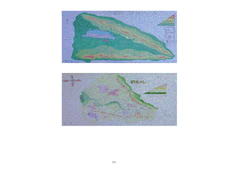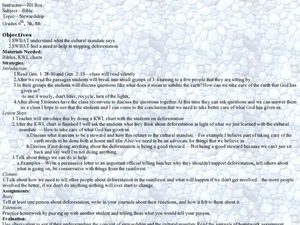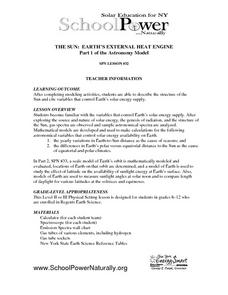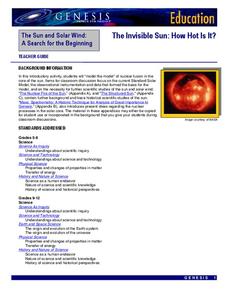Curated OER
Operation Genesis
Students, while working in groups under the Operation Genesis project involve fictional elements of role playing to grasp geographic concepts concerning human/environment interaction. They create the physical features of a fictional...
Curated OER
Animal Habitats: 1st Grade
Learning about animal habitats can be a lot of fun. This instructional activity focuses on how God created different habitats to suit different animal needs. Students will conduct library research in order to create a five page habitat...
Curated OER
From the Moon to the Sun and Back Again
Students consider the aims of the space program, create posters comparing the voyages of Apollo 17 and Genesis and write response papers evaluating NASA's current mission statement.
Curated OER
Nature and You
Students recognize the story of creation in the Bible and begin to discuss endangered animals. In this creation lesson, students focus on a specific species that is endangered and complete a worksheet on how to save them. Students make...
Curated OER
The Language of Science
In this language of science worksheet, students use the list provided to guess the meaning of each of the list. Students apply root words, prefixes, and suffixes to gain meaning of other science words.
Curated OER
Private Sector Enticing Public into Final Frontier
Students study entrepreneurship in space. In this space science lesson, students discuss an article provided and explain why their senses are important to finding opportunities. Students list three possible opportunities in the...
Curated OER
Catch Some Rays?
In this online interactive science rays worksheet, students read 5 questions and choose the multiple choice answer that answers each question correctly. Students answer 1 science question on rays online in the box provided.
Curated OER
Blast's Cosmic Carnival
Young scholars, after analyzing the history of a concentrator, model how a Genesis spacecraft concentrator works by playing a game. In groups of three or four, after being given materials to work with, are challenged to roll the rubber...
Curated OER
Explore the Ocean
Students explore the oceans from their origin. In this oceans instructional activity, students read and discuss excerpts from the Book of Genesis regarding the creation of the ocean. Students then clean up a mock oil spill, measure the...
Curated OER
The Sun: Earth's External Heat Engine Part 1 of the Astronomy Model
Students become familiar with the variables that control Earth's solar energy supply. They explore the source and nature of solar energy, the genesis of radiation, and the structrue of the Sun, gas spectra are observed and sample...
Curated OER
Algae
In this biology activity, students identify and locate various vocabulary terms pertaining to algae. There are 54 biology terms located in the word search.
Curated OER
Stewardship
Students explore deforestation and cultural mandate. In this stewardship lesson, students complete a KWL chart about deforestation and discuss how stewardship relates to the cultural mandate after reading silently in...
Curated OER
Meet the Tiger
Here is an excellent lesson tigers that has a research component. Integrated into the lesson is the premise that God created animals and the human responsibility to care for them. At learning centers students visit various Websites and...
NASA
A Different Perspective
What can we learn from the data? Young scholars analyze actual solar data to answer specific questions. The activity presents an opportunity for an open-ended investigation of the data to conclude a five-part series on solar winds.
NASA
Catch a Piece of the Sun
What does the sun mean to you? Learners have many different interests that may have connections to the sun. Whether its solar radiation, solar flares, or solar storms, there are connections to daily interests that may surprise your...
Curated OER
Cosmic Chemistry: An Elemental Question
Space scientists investigate the cosmic phenomena in order to search for answers to possible origins of the solar system. They consider the concepts of elements and isotopes. Data is analyzed looking at tje abundance of elements...
NASA
Exploring Data
Bring the sun to your class! Young scholars analyze actual solar wind data in the second lesson plan of a five-part series. Their analysis includes speed, temperature, and density data.
Curated OER
The Sun: Earth's External Heat Engine - Part 1 of the Astronomy Model
Designed by School Power...NaturallySM, this lesson familiarizes advanced earth science and physics learners about the variables that affect our supply of solar energy. They examine gas spectra and perform calculations. There is an...
Genesis Energy
Harnessing Solar Energy
How does additional daylight hours affect people and nature? With the help from the legend Maui and the Sun and a grand conversation, scholars complete a graphic organizer to distinguish between the positive and...
National Institute of Open Schooling
Periodic Table and Atomic Properties
An in-depth lesson, the fourth activity in a series of 36, begins with teaching how the periodic table's arrangement came to its current design. Using this knowledge, pupils then move on to analyze the arrangement of elements to their...
NASA
The Invisible Sun: How Hot Is It?
It's getting hot in here! The first in a series of six lessons has learners model nuclear fusion with a simple lab investigation. Groups collect data and analyze results, comparing their models to the actual process along the way.
Curated OER
Soil's Secret
Students examine two types of soils in their area. They identify its texture and permeability to determine its origin. They share their results with the class.
Curated OER
Guardians of Eden
Learners understand the definition of a guardian and the role of the guardian in caring for something. In this Garden of Eden lesson, students examine how a guardian takes care of a garden. Learners complete worksheets on being a...
Curated OER
Unit Conversion Problems
In this unit conversion worksheet, students solve 15 problems by using conversion factors to find their answers. They show all their work and express their answers in scientific notation with the proper number of significant figures.

























